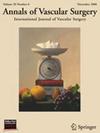Outcomes of Revascularization for Peripheral Artery Disease in Aboriginal and Torres Strait Islander Peoples and Non-Indigenous Australians
IF 1.4
4区 医学
Q3 PERIPHERAL VASCULAR DISEASE
引用次数: 0
Abstract
Background
Australia's Aboriginal and Torres Strait Islander Peoples are at high risk of peripheral arterial disease (PAD), but outcomes of revascularization are unknown. Revascularization outcomes were compared among Aboriginal and Torres Strait Islander and non-Indigenous Australians.
Methods
A retrospective cohort study was conducted of patients who underwent lower limb revascularization between January 2015 and July 2023. PAD severity was defined using the Rutherford classification and angiographic scoring systems (ANGIO score, Global Limb Anatomic Staging System [GLASS], Trans-Atlantic Inter-Society Consensus). The primary outcome was major adverse limb events (MALE), that is, major amputation or repeat revascularization. The secondary outcomes were major adverse cardiovascular events (MACE), major amputation, and repeat revascularization alone.
Results
A total of 504 patients were included. Fifty-seven (11.3%) were Aboriginal and Torres Strait Islander People, who were more likely to present with chronic limb-threatening ischemia (74% vs. 65%; P = 0.01) and have infrapopliteal disease (GLASS: odds ratio [OR] 1.93, 95% confidence interval 1.15–3.24; P = 0.013; ANGIO score: OR 1.97, 1.18–3.29; P = 0.01) compared to non-Indigenous Australians. Risk of MALE (rate ratio [RR] 1.39; 0.91–2.13; P = 0.126) and repeat revascularization (RR 1.18, 0.74–1.88; P = 0.493) were similar, but Aboriginal and Torres Strait Islander People had a higher risk of major amputation (RR 3.35; 1.66–6.75; P = 0.001) and MACE (RR 1.88, 1.17–3.03; P = 0.009) than non-Indigenous participants. Adjusted analyses suggested the increased risk of major amputation was due to Aboriginal and Torres Strait Islander People presenting with more severe PAD and tissue loss compared to non-Indigenous patients.
Conclusion
Aboriginal and Torres Strait Islander Peoples present with more severe PAD and have greater risk of major amputation. Culturally appropriate programs are needed to raise awareness and promote secondary prevention.
求助全文
约1分钟内获得全文
求助全文
来源期刊
CiteScore
3.00
自引率
13.30%
发文量
603
审稿时长
50 days
期刊介绍:
Annals of Vascular Surgery, published eight times a year, invites original manuscripts reporting clinical and experimental work in vascular surgery for peer review. Articles may be submitted for the following sections of the journal:
Clinical Research (reports of clinical series, new drug or medical device trials)
Basic Science Research (new investigations, experimental work)
Case Reports (reports on a limited series of patients)
General Reviews (scholarly review of the existing literature on a relevant topic)
Developments in Endovascular and Endoscopic Surgery
Selected Techniques (technical maneuvers)
Historical Notes (interesting vignettes from the early days of vascular surgery)
Editorials/Correspondence

 求助内容:
求助内容: 应助结果提醒方式:
应助结果提醒方式:


